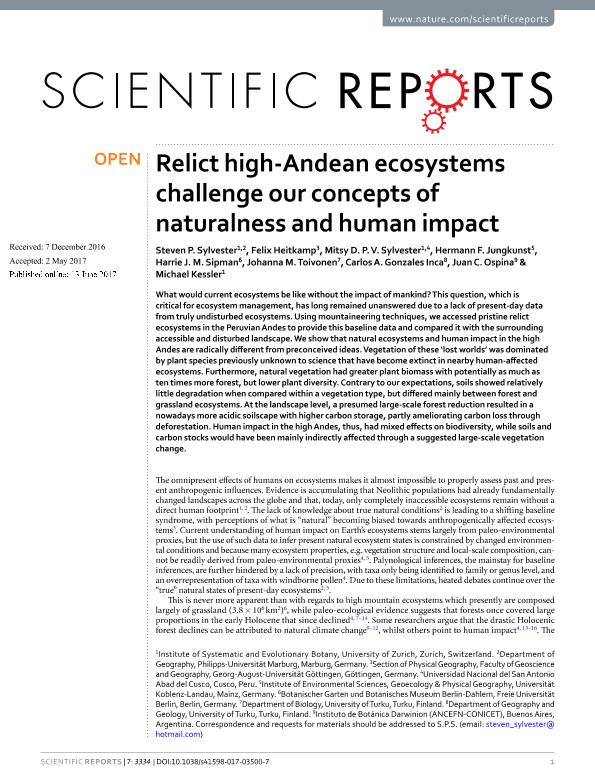Mostrar el registro sencillo del ítem
dc.contributor.author
Sylvester, Steven P.

dc.contributor.author
Heitkamp, Felix
dc.contributor.author
Sylvester, Mitsy D. P. V.

dc.contributor.author
Jungkunst, Hermann F.
dc.contributor.author
Sipman, Harrie J. M.
dc.contributor.author
Toivonen, Johanna M.
dc.contributor.author
Gonzales Inca, Carlos A.
dc.contributor.author
Ospina Gonzalez, Juan Camilo

dc.contributor.author
Kessler, Michael
dc.date.available
2018-05-07T13:37:08Z
dc.date.issued
2017-06
dc.identifier.citation
Sylvester, Steven P.; Heitkamp, Felix; Sylvester, Mitsy D. P. V.; Jungkunst, Hermann F.; Sipman, Harrie J. M.; et al.; Relict high-Andean ecosystems challenge our concepts of naturalness and human impact; Nature Publishing Group; Scientific Reports; 7; 3334; 6-2017; 1-13
dc.identifier.issn
2045-2322
dc.identifier.uri
http://hdl.handle.net/11336/44271
dc.description.abstract
What would current ecosystems be like without the impact of mankind? This question, which is critical for ecosystem management, has long remained unanswered due to a lack of present-day data from truly undisturbed ecosystems. Using mountaineering techniques, we accessed pristine relict ecosystems in the Peruvian Andes to provide this baseline data and compared it with the surrounding accessible and disturbed landscape. We show that natural ecosystems and human impact in the high Andes are radically different from preconceived ideas. Vegetation of these ‘lost worlds’ was dominated by plant species previously unknown to science that have become extinct in nearby human-affected ecosystems. Furthermore, natural vegetation had greater plant biomass with potentially as much as ten times more forest, but lower plant diversity. Contrary to our expectations, soils showed relatively little degradation when compared within a vegetation type, but differed mainly between forest and grassland ecosystems. At the landscape level, a presumed large-scale forest reduction resulted in a nowadays more acidic soilscape with higher carbon storage, partly ameliorating carbon loss through deforestation. Human impact in the high Andes, thus, had mixed effects on biodiversity, while soils and carbon stocks would have been mainly indirectly affected through a suggested large-scale vegetation change.
dc.format
application/pdf
dc.language.iso
eng
dc.publisher
Nature Publishing Group

dc.rights
info:eu-repo/semantics/openAccess
dc.rights.uri
https://creativecommons.org/licenses/by-nc-sa/2.5/ar/
dc.subject
Human Impact
dc.subject
Andes
dc.subject
Vegetation Change
dc.subject.classification
Otras Ciencias Biológicas

dc.subject.classification
Ciencias Biológicas

dc.subject.classification
CIENCIAS NATURALES Y EXACTAS

dc.title
Relict high-Andean ecosystems challenge our concepts of naturalness and human impact
dc.type
info:eu-repo/semantics/article
dc.type
info:ar-repo/semantics/artículo
dc.type
info:eu-repo/semantics/publishedVersion
dc.date.updated
2018-05-04T15:11:08Z
dc.journal.volume
7
dc.journal.number
3334
dc.journal.pagination
1-13
dc.journal.pais
Reino Unido

dc.journal.ciudad
Londres
dc.description.fil
Fil: Sylvester, Steven P.. Universitat Zurich; Suiza. Philipps-Universität Marburg; Alemania
dc.description.fil
Fil: Heitkamp, Felix. Universität Göttingen; Alemania
dc.description.fil
Fil: Sylvester, Mitsy D. P. V.. Universitat Zurich; Suiza. Universidad Nacional del San Antonio Abad del Cusco; Perú
dc.description.fil
Fil: Jungkunst, Hermann F.. Universität Koblenz-Landau; Alemania
dc.description.fil
Fil: Sipman, Harrie J. M.. Freie Universität Berlin; Alemania
dc.description.fil
Fil: Toivonen, Johanna M.. University of Turku; Finlandia
dc.description.fil
Fil: Gonzales Inca, Carlos A.. University of Turku; Finlandia
dc.description.fil
Fil: Ospina Gonzalez, Juan Camilo. Consejo Nacional de Investigaciones Científicas y Técnicas. Instituto de Botánica Darwinion. Academia Nacional de Ciencias Exactas, Físicas y Naturales. Instituto de Botánica Darwinion; Argentina
dc.description.fil
Fil: Kessler, Michael. Universitat Zurich; Suiza
dc.journal.title
Scientific Reports
dc.relation.alternativeid
info:eu-repo/semantics/altIdentifier/doi/http://dx.doi.org/10.1038/s41598-017-03500-7
dc.relation.alternativeid
info:eu-repo/semantics/altIdentifier/url/https://www.nature.com/articles/s41598-017-03500-7
Archivos asociados
